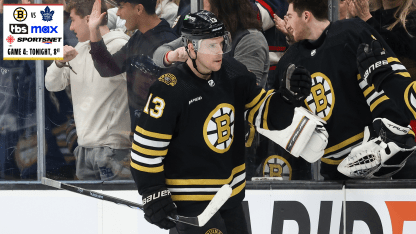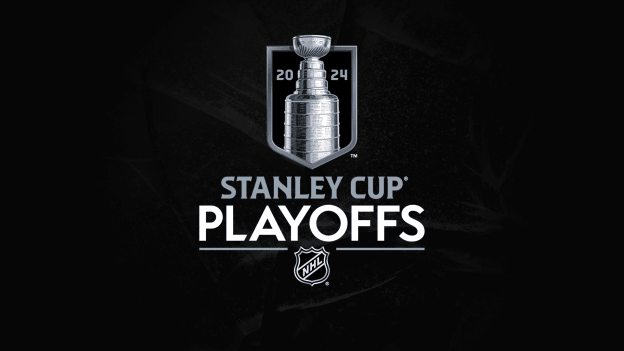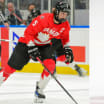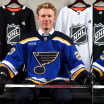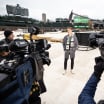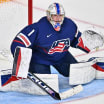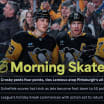BOSTON – For each of the five-plus seasons that Charlie Coyle has spent as a member of the Boston Bruins, and the two previous ones with the Minnesota Wild, he has taken the ice every night, almost every game, playing his relentless style of hockey, using his strength and power to muscle past opponents, his stickiness to grind them to dust on the penalty kill. He has played all 82 games each of the past three seasons, 17 minutes a game of hard-nosed hockey.
And he did all of it while not being able to jump. Or sprint.
“You get used to it at some point, like, this is what I’m dealing with,” Coyle said.
As Coyle sits in the Bruins dressing room on this day late in the 2023-24 campaign, he’s not exactly planning to reveal what he’s been going through for the past seven seasons. But when he’s asked about what he did differently last offseason, what changed for him as he sat on the brink of a new role and a new responsibility and a new chance to prove himself, he can’t help but be honest.
“As far as in the gym?” he blows out air in a gesture of emphasis. “I haven’t been able to train the way I’ve been able to train until this summer. For the last six years, I’ve had issues. … This was the first summer where I could do everything, jump, run. I haven’t run or jumped in like five years, six years.”
It was a transformational summer. For the Bruins. For Coyle.
After the 2022-23 season, the Bruins lost two centers who had held down the position for the past decade and a half, Patrice Bergeron, and David Krejci. The simultaneous departure of two franchise icons opened spots down the middle for Coyle and Pavel Zacha. It was a season in which the Bruins were coming off a historic regular season and a tremendously disappointing Stanley Cup Playoffs, getting knocked out in the Eastern Conference First Round.
It would mark the biggest opportunity of Coyle’s career.
And he has responded. Coyle put up an NHL career season in 2023-24, with 60 points (25 goals, 35 assists), besting previous highs of 56 points (2016-17) and 21 goals (2015-16), coming when he played for the Wild.
He stabilized the Bruins’ top six in a surprisingly strong season for Boston, which finished second in the Atlantic Division. His assist in Game 3 of the Eastern Conference First Round helped the Bruins take a 2-1 lead in the best-of-7 series against the Toronto Maple Leafs. Game 4 is Saturday at Scotiabank Arena in Toronto (8 p.m. ET; CBC, TVAS, SN, NESN, TBS, truTV, MAX).
Asked if he would make a connection between his ability to train without pain this summer and those numbers, Coyle acknowledged, “I think it could help. I think that’s a part that would help. Playing with some good linemates helps. A little more ice time helps. It’s never one thing. It’s a whole bunch of things.
“But I think being able to train properly has definitely been huge for preparing for the year that I wanted to have.”
He starts laughing, understanding that he hasn’t exactly been open about his limitations.
“Did it affect me?” he admitted. “Yeah, it affected me. But, yeah. I got to the bottom of it. Now I’m good. It’s like a breath of fresh air now. It wasn’t fun.”
He chuckles, again.
Coyle had broken his right fibula on October 12, 2017, while playing for the Wild. He underwent surgery and was out until Nov. 20. But, compensating for the original injury, he over-relied on his left leg. Over time, the muscle started pulling on his tendon. Eventually, it tore.
“But I didn’t know it for a few years,” he said.
In the summer of 2021, after his first full season as a member of the Bruins, Coyle had a second surgery, this time to repair an avulsion fracture in his left kneecap and a small tear of the patellar tendon. He was ready for training camp that fall. Coyle added an injection in the summer of 2022 -- “That set me behind, I still couldn’t do stuff,” he said – and it was only last summer that his knee finally, finally, finally felt better.
“This summer I was able to train fully on my leg,” he said. “It was awesome. I hadn’t ran or jumped in a while. So you feel good. Sometimes when you don’t do that, you feel like you’re just planted to the ground. You have no spring, you have no jump. So that was a big thing this summer was I was able to train without any restrictions.
“That’s been huge. So I’ve kind of been able to feel myself. It’s the best I’ve felt in six years.”
When he had the second surgery, in 2021, and then the injection, it wasn’t as if, boom, he was back to normal. It had impacted so much, including his ability to do lower-body work that put stress on the area. Coyle had to spend much of his time working though recovery, stabilizing the area, doing maintenance.
“So this past offseason really was the first one -- certainly in Charlie’s time with us and I think it extended into his time in Minnesota as well -- that he entered the offseason 100 percent healthy without any significant ailments that we would have to work around,” Bruins head performance coach Kevin Neeld said.
Training has always been important to Coyle. So it was as much a mental challenge as a physical one to not be able to do what he wanted in the gym, to be able to run or jump or move in ways that could improve his fitness and his game.
He found he was always thinking about it. It was always there.
“I’ve always loved training and being able to push yourself and just get into that mode,” Coyle said. “It’s another way to gain an advantage out there. … For the most part guys are healthy and they can take full advantage of their training in the offseason. It’s like, you feel like you’re behind. You’re limited, you can’t do this, can’t do that. It’s like, well, these guys are going to get a jump on me.”
Coyle has long spent his offseasons in Boston, training in Foxboro with Brian McDonough at Edge Performance Systems, where his sister, Jess Coyle Campbell, also works as director of operations and strength coach. But the past two offseasons, Coyle has worked closely with Neeld in getting himself ready for the season.
When he started with Neeld this summer, the pair were thrilled to see where he was.
He could do shuttle runs. For that matter, he could warm up. Even something as basic as high knees was problematic for him before. But he also had to relearn how to stop compensating for the injuries that he’d worked around for so long.
“There’s a little bit of a re-education process that needs to take place, even on a subconscious level to just teach the body to start to integrate and reload through an area that it’s been avoiding for prolonged periods of time,” Neeld said.
That meant that Coyle and Neeld had to work in a transitional process, slowly building up his exposure and ensuring that he was loading in a way that was both productive and safe.
“When you’re used to navigating around pain or an injury for prolonged periods of time you develop a little bit of a hesitation to perform certain movements and I think that was one of the things that we really focused on this past summer,” Neeld said.
They also had priorities related to his potential change in status. They believed he would earn more minutes, that he would be relied on for speed and durability as his ice time increased, from 16:59 per game last season to 18:03 this season, that his conditioning would need to be at its peak.
“Being able to train with less restrictions allowed us to do a little more sprint work than we had done in the past. It allowed us to do more jumping and some lower-body power training strategies that we had not been able to do in the past,” Neeld said, noting he could do some training on the ground as opposed to on bikes or a machine. “I think that those things have benefitted him. … It’s allowed him a larger bandwidth of strategies to be able to make those improvements.”
Neeld said it helped that Coyle came in with an “incredible foundation of strength” before he arrived in Boston. But, now 32, Coyle’s priorities would need to shift, and Neeld helped him focus on durability and being pain-free going into camp, on improvements in speed and power.
“I think the success that Charlie’s experienced thus far this season, I don’t think really surprises anybody,” Neeld said. “I think more than anything, I’m just happy that he had the opportunity to take on an expanded role and that he’s seized that opportunity and thrived inside of it.”
Asked what was most exciting for him, Coyle said, “Literally just [being able to] move. Like run and jump. Just be able to move and not feel anything and just be able to go. You know when you get old … and you can’t move? I’m like, I don’t want that right now. I’m in my 30s.”
Coyle doesn’t blame the training staffs, in either of his stops. In fact, he makes it very clear that he’s not exactly one to speak up, to complain. He tends to shrug it off, believing that it will be fine, that he will be fine, that it will all be fine. Even if it isn’t. It’s part of the ethos of hockey, after all.
“I’m not big on saying stuff,” he said, even as his girlfriend (now wife) was nudging him to get more help.
He admitted that, should the situation arise again, he would probably be more vocal.
“That’s part of his character that he’s very conscious about not making anybody else look bad,” Neeld said. “That’s kind of built into hockey, too, is its ingrained in you at an early age that you’re going to have to play through pain. There’s some discomfort associated with the sport and certainly as the season progresses along everybody’s going to play through some bumps and bruises. It’s hard for players to speak up when they’re experiencing something that is uncomfortable, but they can play through it.
“That’s a little bit of a relearning process for players at this level.”
When those around Coyle talk about him, they tend to talk in superlatives, with Neeld praising his professionalism and work ethic and attention to detail, with former coach Bruce Boudreau calling him “one of the best people in the world."
Boudreau coached Coyle in his final three seasons with the Wild, before the Massachusetts native was traded to the Bruins on Feb. 20, 2019, for Ryan Donato and a fourth-round pick in the 2019 NHL Draft, a move that still makes Boudreau grumble, long after his tenure with the Wild has ended.
“In the three years that I did have him, the biggest problem was he’s so good at everything that he never got to be in a stable spot,” Boudreau said. “Whatever I needed, Charlie would fill. He was the go-to guy.”
Coyle was a jack of all trades, in many ways, able to be slotted in anywhere he was needed. And, mostly, he didn’t complain, didn’t contest his role, until the time that he finally came into his coach’s office not long before the trade and made a simple request: “’Bruce, I just want to be on one line,’” Boudreau recalled Coyle saying. “’If you could put me in one spot, that would be great.’”
Since coming to Boston, Coyle has mostly played center, even if he manned the third line at times behind Bergeron and Krejci, something general manager Don Sweeney called “an incredible luxury.” It has made life easier for the forward, granting him the steadiness he craved.
But this is not just stability. This is a featured role. This is top-six duty.
He’s been waiting for this for so long.
"It’s difficult to be consistent when you’re not in a consistent role, you don’t know where you’re going to be on a nightly basis,” Coyle said. “But I took pride in that. I liked being a guy who can fill in here and play with different guys, play in different lineups. And when you’re young, you just want to play. … But then there’s a time where you’re like, I think I can really play better when I’m in this one spot, I can fully take advantage of that. So that’s always been something I’ve wanted. It’s nice to finally get there. But now you’ve got to take advantage of it."
Coyle has been talking in the Bruins’ dressing room for nearly 15 minutes when Neeld comes over.
“Are we going to come in and get better today?” Neeld asks.
The forward says he’ll be there soon. He wants nothing more than to keep getting better, to keep himself healthy and able to continue to make good on the opportunities he’s been given.
“I’ve wanted this for a while,” Coyle said. “So it’s nice that it’s here and I’m feeling healthy to do it and hit it in stride. It just all came together at the right time.”
